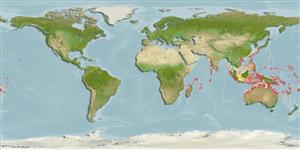Common names from other countries
>
Eupercaria/misc (Various families in series Eupercaria) >
Labridae (Wrasses) > Corinae
Etymology: Pseudocoris: Greek, pseudes = false + Greek, kore = pupil (Ref. 45335).
Environment: milieu / climate zone / depth range / distribution range
Ekologi
marina revassocierade; djupintervall 5 - 90 m (Ref. 90102). Tropical; 32°N - 30°S, 57°E - 178°W
Western Pacific: Micronesia to Samoa; reported from Rowley Shoals (Ref. 1602) and Kermadec Islands (Ref. 8879). Reported to extend to the Indian Ocean: Maldives (Ref. 11303), Mauritius and East Africa (Ref. 9710), Christmas Island (Ref. 30874).
Size / Vikt / Age
Maturity: Lm ? range ? - ? cm
Max length : 16.0 cm TL hane/ej könsbestämd; (Ref. 48636)
Short description
Bestämningsnycklar | Morfologi | Morfometri
Taggstrålar i ryggfenan (totalt) : 9; Mjukstrålar i ryggfenan (totalt) : 12; Taggstrålar i analfenan: 3; Mjukstrålar i analfenan: 12. Dorsal half of body dark, or without distinct markings. Anteriormost pair of teeth on lower jaw distinctly larger than other teeth. First dorsal spin in males elongated. Caudal fin emarginate or truncate (Ref. 43239).
Found up to a depth of at least 25 m in lagoon, channel and seaward reefs (Ref. 9710). Often on open sand flats with large remote bommies in depths of about 20 m. Juveniles congregate on reefs, usually in depths of 10-20 m feeding on mysids (Ref. 48636). Aggregates (with females outnumbering the males) along upper edges of coral slopes to feed on zooplankton (Ref. 9710, 48636). Maximum depth reported taken from Ref. 128797.
Life cycle and mating behavior
Maturities | Reproduktion | Spawnings | Egg(s) | Fecundities | Larver
Oviparous, distinct pairing during breeding (Ref. 205).
Randall, J.E., G.R. Allen and R.C. Steene, 1990. Fishes of the Great Barrier Reef and Coral Sea. University of Hawaii Press, Honolulu, Hawaii. 506 p. (Ref. 2334)
IUCN Red List Status (Ref. 130435)
CITES (Ref. 128078)
Not Evaluated
Threat to humans
Harmless
Human uses
Fiskeri: saknar intresse; Akvarium: Kommersiell
Verktyg
Special reports
Download XML
Internet-källor
Estimates based on models
Preferred temperature (Ref.
115969): 24.6 - 29.3, mean 28.4 (based on 1811 cells).
Phylogenetic diversity index (Ref.
82804): PD
50 = 0.5020 [Uniqueness, from 0.5 = low to 2.0 = high].
Bayesian length-weight: a=0.00490 (0.00204 - 0.01176), b=3.11 (2.90 - 3.32), in cm Total Length, based on LWR estimates for this (Sub)family-body shape (Ref.
93245).
Trofisk nivå (Ref.
69278): 3.4 ±0.45 se; based on food items.
Resiliens (Ref.
120179): Hög, lägsta populationsfördubblingstid mindre än 15 månader (Preliminary K or Fecundity.).
Fishing Vulnerability (Ref.
59153): Low vulnerability (10 of 100).
